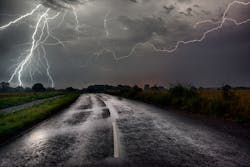OSHA Warns of Hazards During Hurricane Matthew Cleanup
Severe flooding, power outages and storm damage were left after the hurricane came up the Florida coast and battered the Carolinas the first week of October.
Numerous counties are reporting damage into the hundreds of millions of dollars, and cleanup could take weeks, according to news sources. OSHA is reminding emergency workers, employers and the public at-large about the potentially serious hazards that come with storm cleanup and urges “vigilance”.
"Recovery work should not send you to the hospital emergency room," said Kurt Petermeyer, OSHA's regional administrator for the Southeast in a statement. "A range of safety and health hazards exist following storms. You can minimize these dangers with knowledge, safe work practices and personal protective equipment. OSHA wants all working men and women - including volunteers - to stay safe once the storm has passed."
Storm and tornado cleanup may involve hazards related to restoring electricity, communications, and water and sewer services. Demolition activities such as debris cleanup, tree trimming and structural, roadway and bridge repair, hazardous waste operations and emergency response activities present their own unique hazards, according to OSHA.
As flood waters continue to rise in Eastern North Carolina in particular, dam and levee repair, floodwater removal, and downed electrical wire pose different challenges. OSHA is reminding workers and residents to be cautious around rapidly rising streams and moving water. Resources on flood preparedness and response are available on OSHA's website.
Above all, only properly trained and adequately equipped workers should conduct cleanup activities, the agency warned.
OSHA recommends the proposed measures for workers engaged in cleanup efforts:
- Evaluate all work areas for hazards.
- Employ engineering or work practice controls to mitigate hazards.
- Use personal protective equipment.
- Assume all power lines are live.
- Use portable generators, saws, ladders, vehicles and other equipment properly.
- Heed safety precautions for traffic work zones.
Individuals involved in recovery efforts may call OSHA's toll-free hotline at 800-321-OSHA (6742) or visit the agency's website to reach local representatives who can provide on-site assistance.
